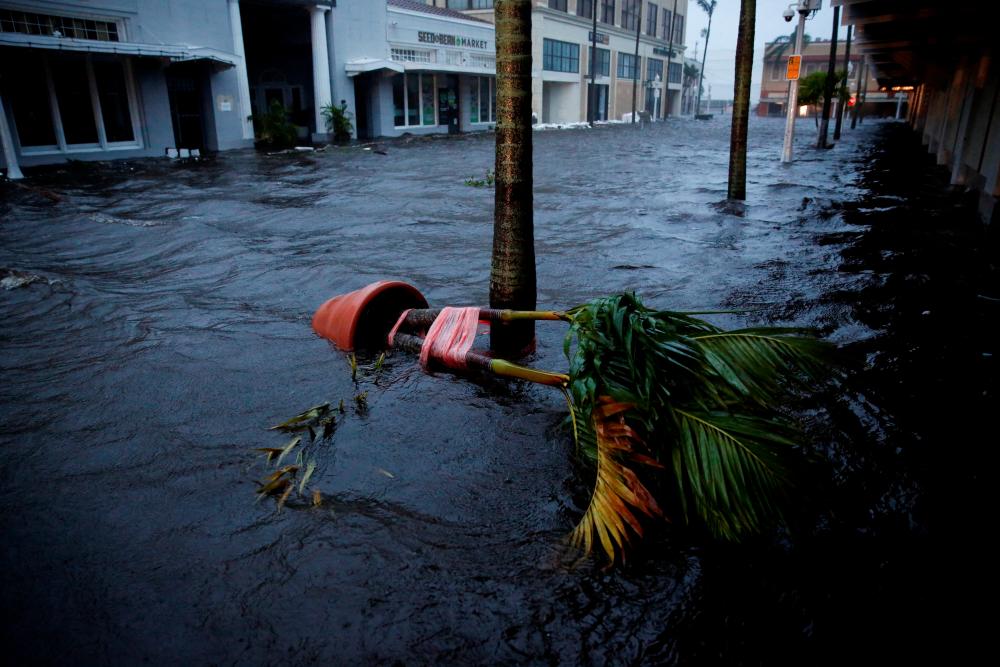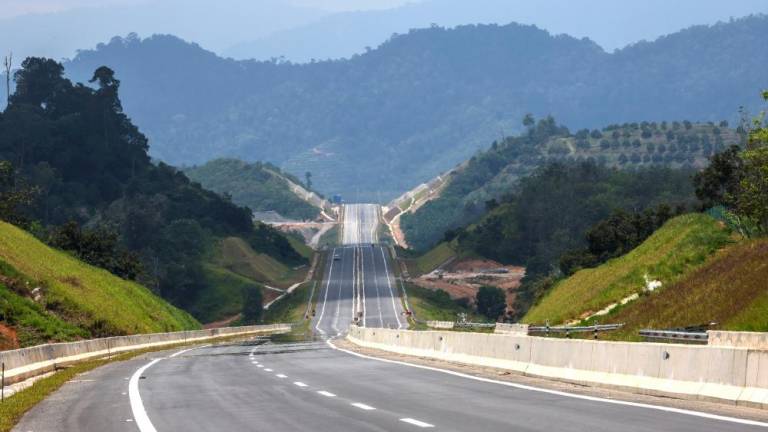VENICE: Hurricane Ian plowed into Florida’s Gulf Coast on Wednesday as one of the most powerful U.S. storms in recent years, assaulting the state with howling winds, torrential rain and a treacherous surge of ocean surf.
Ian made landfall at 3:05 p.m. EDT (1905 GMT) near Cayo Costa, a barrier island just west of Fort Myers, as a Category 4 hurricane, with sustained winds of up to 150 miles per hour (241 km per hour), the U.S. National Hurricane Center (NHC) reported.
The storm’s wind speeds put it just shy of a Category 5 designation on the Saffir-Simpson scale, the most severe classification for storms with maximum sustained winds of at least 157 mph.
The region around the landfall zone is home to miles of sandy beaches, scores of resort hotels and numerous mobile home parks, a favorite with retirees and vacationers alike. But the storm soon transformed idyllic coastal communities into disaster zones.
An hour after landfall, video posted on social media and local TV stations showed water fueled by the powerful storm surge rushing through communities, nearly at the rooftops of homes. The town of Fort Myers Beach was nearly submerged by floodwaters and the ruins of homes could be seen floating downstream, along with cars.
A view of Sanibel Island posted on Twitter showed the ocean rushing over the seawall and flooding into a resort hotel’s swimming pool. Other video from the island showed roads inundated by the storm surge, rising up to the tops of street signs.
Video posted on Twitter by a local reporter showed the ruins of several homes floating in floodwaters at Fort Myers Beach. A live camera shot from Sanibel Island on Twitter showed palm trees bent sideways amid a torrent of near blinding rain and wind as enormous waves crashed up a beach and onto a road.
Forecasters say Ian would unleash storm surges - wind-driven coastal flooding - of up to 18 feet (3.7 meters) along with intense thunderstorms and possible tornadoes.
“This is a storm that we will talk about for many years to come, an historic event,“ said Ken Graham, director of the National Weather Service.
Even as Ian lashed Florida’s Gulf Coast with fierce winds and drenching rains in the final hours before it swept ashore, authorities warned residents it was too late for anyone who had yet to evacuate to safely do so.
In terms of its sustained wind speeds, which peaked at 155 mph before landfall, Ian ranks as one of the most ferocious hurricanes to strike the U.S. mainland in recent years. By comparison, Hurricane Michael came ashore in Florida’s panhandle with steady winds of 155 mph, while Ida last year packed sustained winds of 150 mph when it landed in Louisiana.
The Weather Channel reported that Ian made landfall in the exact same point where Hurricane Charley made landfall in 2004 as a Category 4 storm. Both hurricanes had winds of 150 mph at landfall.
Ian was expected to weaken a notch after coming ashore, according to the NHC.
Ian knocked out power to over 1 million customers so far.
Earlier this week, authorities told more than 2.5 million residents to evacuate. Doug Coe of Venice was one of those residents who chose to ignore warnings and stay put. As he walked through rainfall on Wednesday morning to see how a friend’s home was weathering the storm, Coe admitted to never experiencing a storm of such magnitude, but he seemed unfazed by the prospects of it ravaging his neighborhood.
“You have to be vigilant because you never know what’s going to happen with it,“ he said. “I’m staying vigilant, but trying not to worry.”
Hotels along Interstate Highway 75, which runs up and down Florida’s west coast, were jam packed with people seeking shelter. The region is dotted with mobile home parks, which most residents had abandoned, taking refuge in local schools and other facilities converted to emergency shelters. The area’s numerous assisted-living facilities were mostly evacuated, too.
Heartis Venice, an assisted-living home north of Venice, was an exception. Of its 107 residents, 98 decided to stay put and continue receiving care with help of staff and some family members, general manager Michelle Barger said. The facility, opened two years ago, was built to withstand a Category 5 storm.
The facility stocked up on enough food and water to last more than seven days, as well as all medications and supplies needed to provide services, Barger said.
“Our community is locked down. We’re secure and we’re prepared for this,“ she said.
WARMING PLANET
Climate change is making hurricanes wetter, windier and more intense. There is also evidence that it is causing storms to travel more slowly, meaning they can dump more water in one place, scientists say.
“Hurricane Ian’s rapid intensification could prove to be another example of how a warming planet is changing hurricanes,“ said Kait Parker, meteorologist and climate scientist at IBM’s weather.com. “Research shows we are seeing this far more often than we did in decades past.”
On Tuesday, the storm thrashed Cuba, knocking out the electrical grid for 11 million people and ravaging the western end of the Caribbean island nation with violent winds and flooding. By early Wednesday, the state electricity provider said it had begun to restore power across eastern Cuba. - Reuters














